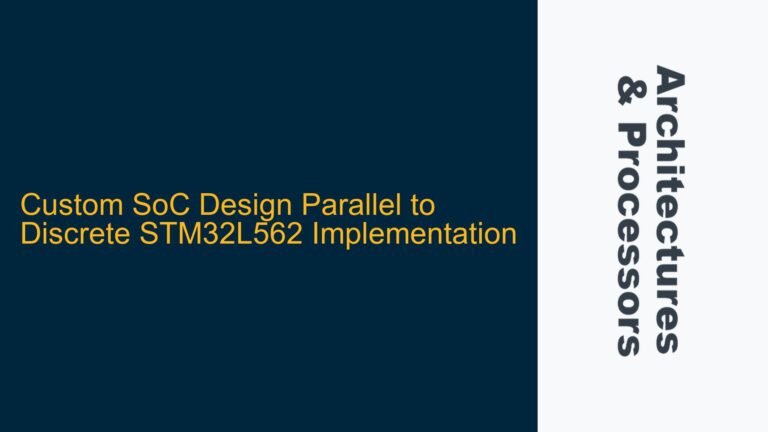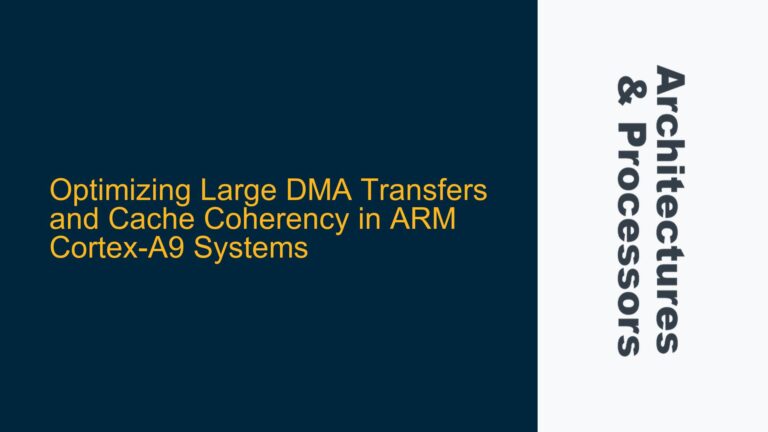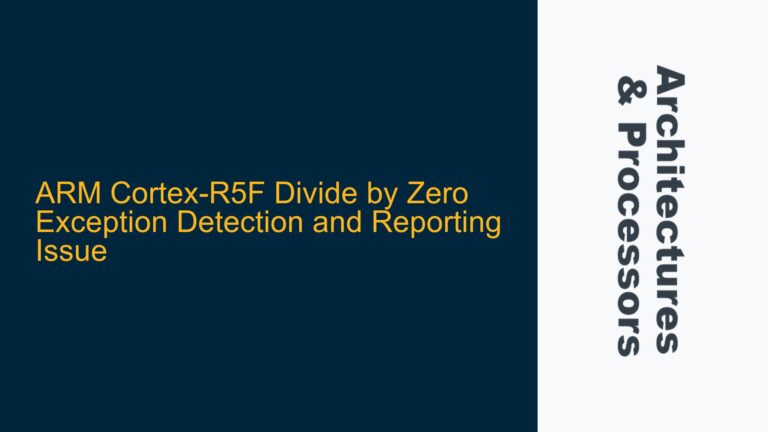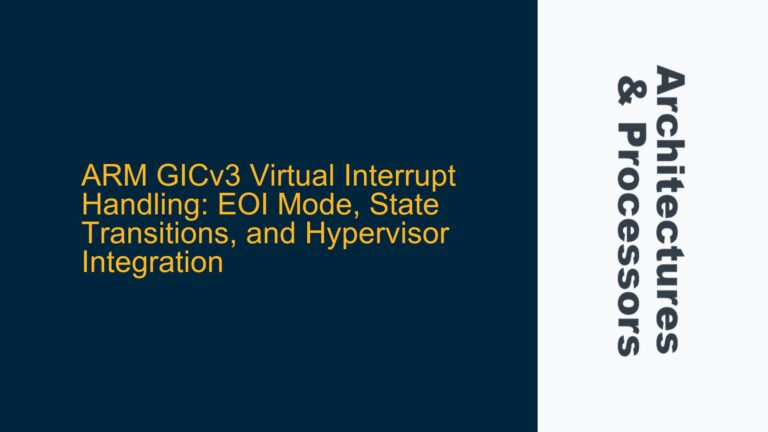ARM Cortex-R5 Twin CPU Configuration and Instruction Synchronization
The ARM Cortex-R5 processor is designed for real-time applications, offering dual-core (twin CPU) configurations that enable high-performance, fault-tolerant systems. However, configuring and synchronizing twin CPUs in the Cortex-R5 architecture presents unique challenges, particularly when writing instructions that ensure both cores operate in harmony without conflicts. The Cortex-R5’s dual-core setup relies on shared resources, such as memory and peripherals, which can lead to race conditions, data corruption, and inconsistent states if not properly managed. Understanding the intricacies of instruction writing for twin CPU configurations is critical to leveraging the full potential of the Cortex-R5 architecture.
The Cortex-R5 twin CPU configuration operates in either Split mode or Lockstep mode. In Split mode, both CPUs execute instructions independently, allowing for parallel processing but requiring explicit synchronization mechanisms to avoid resource contention. In Lockstep mode, both CPUs execute the same instructions simultaneously, providing fault tolerance but limiting performance scalability. Writing instructions for these configurations involves addressing shared memory access, cache coherency, interrupt handling, and inter-core communication. Misconfigurations or improper synchronization can lead to subtle bugs, such as deadlocks, data races, or incorrect execution flows.
One of the primary challenges in twin CPU configurations is ensuring that both cores have a consistent view of shared resources. For example, when one CPU modifies a shared memory location, the other CPU must see the updated value without delay. This requires careful use of memory barriers, cache management instructions, and inter-core communication protocols. Additionally, the Cortex-R5’s memory protection unit (MPU) and cache architecture add complexity, as each CPU has its own MPU and cache, which must be synchronized to maintain coherency.
Shared Resource Contention and Cache Coherency Issues
The root cause of many issues in twin CPU configurations stems from shared resource contention and cache coherency problems. When both CPUs access shared memory or peripherals simultaneously, conflicts can arise if proper synchronization mechanisms are not in place. The Cortex-R5’s cache architecture exacerbates this issue, as each CPU has its own L1 cache, and modifications to shared memory by one CPU may not be immediately visible to the other CPU.
Cache coherency issues occur when one CPU updates a memory location that is cached by the other CPU. Without explicit cache management instructions, the second CPU may continue to use stale data from its cache, leading to incorrect program behavior. The Cortex-R5 provides cache maintenance operations, such as Data Cache Clean and Invalidate, to address this issue. However, improper use of these operations can result in performance bottlenecks or even data corruption.
Shared resource contention also arises when both CPUs attempt to access the same peripheral or memory region simultaneously. For example, if both CPUs attempt to write to a shared UART peripheral, the output may become garbled or incomplete. To prevent such issues, mutual exclusion mechanisms, such as spinlocks or semaphores, must be implemented. These mechanisms ensure that only one CPU can access a shared resource at a time, but they must be carefully designed to avoid deadlocks or priority inversion.
Interrupt handling is another area where shared resource contention can occur. In twin CPU configurations, interrupts must be routed to the appropriate CPU to ensure timely and correct handling. Misconfigured interrupt routing can lead to missed interrupts or excessive latency, degrading system performance. The Cortex-R5’s Generic Interrupt Controller (GIC) provides flexible interrupt routing options, but these must be carefully configured to match the system’s requirements.
Implementing Cache Management and Synchronization Mechanisms
To address the challenges of twin CPU configurations in the Cortex-R5, developers must implement robust cache management and synchronization mechanisms. These mechanisms ensure that both CPUs have a consistent view of shared resources and prevent conflicts during concurrent access.
Cache management involves using the Cortex-R5’s cache maintenance operations to ensure coherency between the CPUs’ caches. When one CPU modifies a shared memory location, it must perform a Data Cache Clean operation to write the modified data back to main memory. The other CPU must then perform a Data Cache Invalidate operation to ensure that it fetches the updated data from main memory rather than using stale data from its cache. These operations must be carefully placed in the code to minimize performance overhead while maintaining coherency.
Synchronization mechanisms, such as spinlocks and semaphores, are essential for managing access to shared resources. Spinlocks are simple mutual exclusion primitives that use busy-waiting to ensure that only one CPU can acquire the lock at a time. However, spinlocks can waste CPU cycles if the lock is held for an extended period. Semaphores, on the other hand, allow CPUs to sleep while waiting for a resource, reducing CPU utilization but introducing additional complexity.
Inter-core communication is another critical aspect of twin CPU configurations. The Cortex-R5 provides hardware primitives, such as the Mailbox and Spinlock peripherals, for inter-core communication. These primitives allow CPUs to exchange messages or synchronize their execution without relying on shared memory. Proper use of these primitives can simplify synchronization and reduce the risk of race conditions.
Interrupt handling must also be carefully configured to ensure that interrupts are routed to the appropriate CPU. The Cortex-R5’s GIC allows interrupts to be routed to either CPU or both CPUs, depending on the system’s requirements. For example, timer interrupts may be routed to both CPUs to support time-sliced scheduling, while peripheral interrupts may be routed to a specific CPU to reduce contention.
Below is a table summarizing the key cache management and synchronization mechanisms for twin CPU configurations in the Cortex-R5:
| Mechanism | Description | Usage Example |
|---|---|---|
| Data Cache Clean | Writes modified cache lines back to main memory | Before releasing a spinlock to ensure other CPU sees updated data |
| Data Cache Invalidate | Marks cache lines as invalid, forcing a fetch from main memory | After acquiring a spinlock to ensure the CPU uses the latest data |
| Spinlock | Mutual exclusion primitive using busy-waiting | Protecting access to a shared peripheral or memory region |
| Semaphore | Mutual exclusion primitive allowing CPUs to sleep while waiting | Managing access to a shared resource with long hold times |
| Mailbox | Hardware primitive for inter-core message passing | Sending commands or data between CPUs |
| GIC Interrupt Routing | Configures which CPU handles specific interrupts | Routing timer interrupts to both CPUs for time-sliced scheduling |
By implementing these mechanisms, developers can ensure that twin CPU configurations in the Cortex-R5 operate reliably and efficiently. Proper cache management and synchronization are essential for avoiding subtle bugs and performance bottlenecks, enabling the Cortex-R5 to deliver its full potential in real-time applications.






